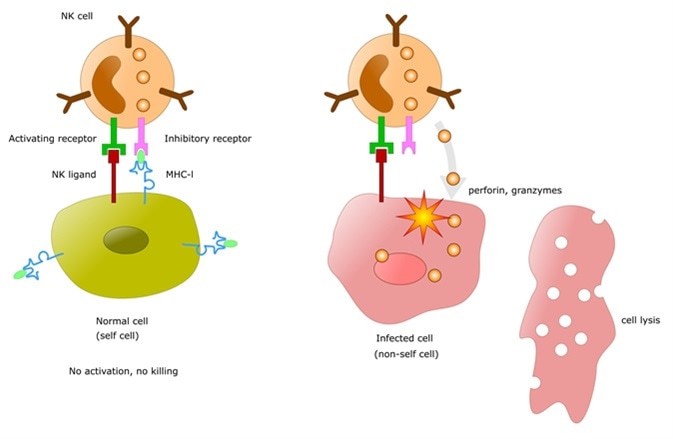Natural killer cells are an integral part of the human immune system, representing the front line of defence against tumor-forming cells and pathogens. These cells utilise several different methods to differentiate between abnormal cells and the host’s own cells, and are coordinated by biochemical signals derived from the activation of their own cell-surface receptors.

Immune system: dual receptor system to activate or not natural killer cells (NK). Image Credit: ellepigrafica / Shutterstock
Natural killer cells are, more specifically, part of the innate immune system, functioning as effector lymphocytes. They prevent many microbial infections, as well as several tumor types, by releasing cytokines, and directly limiting the pathogen’s or tumor cells’ spread to other tissues, thus preventing further damage. To be able to do this efficiently, the natural killer cells must be able to distinguish between abhorrent cells (e.g. tumour cells or pathogens), and the organism’s own cells.
Natural Killer Cells (NK-92) Explainer Video
What is the 'Missing Self' Hypothesis?
In 1981, Dr Klas Kärre presented the idea of ‘missing self’ in a PhD thesis. It states that “one central recognition mechanism of natural killer cells operated by detecting information that was missing in the target, and present in the host”. It was originally thought that natural killer cells were detecting information present on the target cell, as is the case for many other biochemical detection processes in the immune system.
It was observed that an organism’s own cells all have a characteristic major histocompatibility complex molecule on their cell surface (for example: organ tissue cells, symbiotic/microbiome organisms, etc). These molecules therefore act as deterrents for natural killer cells, as they function as a beacon, making it clear that this cell is a part of the organism itself, and therefore should not be a natural killer cell target. Some tumor-forming cells (which are therefore massively abnormal) and pathogens do not possess these cell surface molecules, and therefore leave themselves vulnerable to detection and destruction by the organisms’ natural killer cells.
This process is why natural killer cells are part of the innate immune system - meaning that they do not need prior contact with a certain pathogen/tumour cell to be able to recognise it and destroy it. This is unlike the adaptive immune system, which requires B-cells to come in contact with the abhorrent cells in question and become memory B-cells, ready to recognise these specific cells in the future.
Natural killer cells have therefore been observed to target cells which are missing certain major histocompatibility complex molecules (MHC) – rather than the other way around, as was originally thought. This model was later proven correct, as it was observed that certain MHC molecules were recognised by triggered cell-surface receptors on natural killer cells. The biochemical actions between these receptors therefore blocks the natural killer cells from successfully attacking the cell in question.
A 'Missing Self' Study
A study performed on MHC-congenic mice in 2005 shows a correlation between the expression of an inhibitory receptor for self-MHC-I, and the ability of the mice’s own natural killer cells to become activated to produce cytokines, and ultimately kill the target cell. Mice that had cells lacking the expression of any known self-receptors (MHC) had hyper-responsive immune systems. Unknown self-receptors could possibly have caused this hyper-responsiveness, but nevertheless, the data obtained does fall in line with the ‘missing self’ hypothesis.
The ‘missing self’ model has not yet been definitively proven, as there are many factors which could affect the current experimental findings supporting this hypothesis. However, the data so far seems to point towards the ‘missing self’ hypothesis being the main way in which natural killer cells distinguish and attack abhorrent cells within the body.
Further Reading